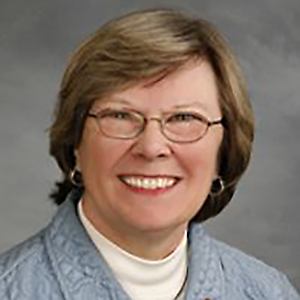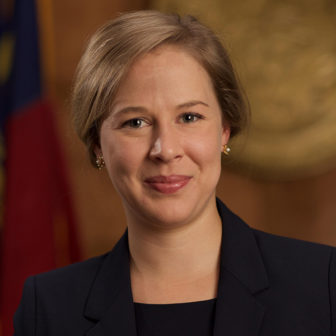With one worried phone call from the mother of a 16-year-old boy, the modern movement that brought raise the age to North Carolina began, drawing legislators, activists, lawyers, parents and kids into a battle that lasted more than 13 years before the state passed its RTA bill in summer 2017.
It took over two more years, until Dec. 1, 2019, before the law — the biggest change to juvenile justice in North Carolina in generations — took effect.

Ballotpedia
Alice Bordsen
“It’s the simplest way I think any legislation ever starts,” said Alice Bordsen, then the Democratic state representative from Mebane, N.C., who received the early 2004 call. “And it was from a constituent, a parent of a 16-year-old from Alamance County who was at a party. He was cited for holding an open beer.”
The boy figured he’d handle it on his own and didn’t tell his parents he had been arrested. It would slide by, he figured. But under North Carolina law at the time, he wasn’t a boy. Sixteen-year-olds were considered adults, and the state had far different plans.
“He was embarrassed about letting his parents down,” Bordsen said. “The child went through the hearing. Then, there was a letter that came to the house notifying them when his sentencing was going to take place. The parents happened to see the letter from the courts. They opened the letter, and what they couldn't understand is: How could this take place and they not be notified? They had a minor child.”
“It was absurd,” added Bordsen, who knew the local district attorney. “I called him to ask him how could this have happened? And he said, ‘Well, it happens every day because he was 16. And under the criminal code, he is an adult, and they don't have to notify the parents — and, most times, the parents don't want to know.’ I was stunned. Just stunned.”
History of raise the age
And so, a mix of one child’s embarrassment, his parents’ lack of knowledge of the law and a new state legislator's bafflement at this same law started in motion a long series of events that would eventually convince — or shame — the state into becoming the last in the nation to adopt a raise the age law.
It was hardly an easy fix.
At the time, the early 2000s, the country was still recovering from the hangover of the superpredator myth, which predicted a “demographic crime bomb” of “radically impulsive, brutally remorseless youngsters, including ever more pre-teenage boys ... who do not fear the stigma of arrest, the pains of imprisonment, or the pangs of conscience.”
With some “experts” forecasting up to 200,000 kids in confinement each day by the 2020s, scared lawmakers nationwide enacted tough-on-crime laws that effectively projected that youths, particularly black and brown boys, would "murder, assault, rape, rob, burglarize, deal deadly drugs, join gun-toting gangs, and create serious communal disorder" for years to come.
Democrats and Republicans alike bought into the theory most associated with political scientist John DiIulio, as evidenced by the passage of the 1994 crime bill that escalated prison populations to historic highs. Yet, it was just that, a myth, as juvenile crime rates actually dropped over the coming years, and facilities built to house criminal teens sat empty or barely occupied in many cases.
The South can be especially reticent to enact progressive change with criminal justice laws, Bordsen said. She immediately, and frequently, ran into resistance as she started the long push uphill for laws to loosen juvenile justice punishment.
[Early Data Shows Raise the Age Slowly Taking Effect For North Carolina’s Juveniles]
And while all this activity began with that 2004 phone call, one would have to rewind to 1915 — or earlier — to really understand just how long the idea had been around, according to Tamar Birckhead, a defense attorney and former law professor at the University of North Carolina at Chapel Hill.
In 2012, she wrote about being stunned — upon her 2004 arrival in North Carolina from Massachusetts — over laws that set adulthood in the juvenile system at 16 while most of the country recognized the age of 18. (In fact, in 2004 only Connecticut and New York had yet to raise the age. But both of those states had made progress toward change, leaving North Carolina the only one without such a bill.)
"I gave a lot of thought to how this came to be, why it was that North Carolina — considered one of the more progressive and enlightened in the South — was so backward in this regard,” she wrote.
So Birckhead dug in at the library, wrote about the failed efforts over the decades and figured that, "Surely it could be agreed that juvenile delinquency court should have original jurisdiction of these youth, particularly given that probation supervision is much more rigorous in the juvenile system and that empirical data confirmed that recidivism rates would drop when this cohort received age-appropriate treatment.”
But, she was quick to add in the piece, "How naive I was."
Indeed, there were efforts in the 1940s, 1950s and 1960s to change the age of adult jurisdiction to 18 and erase a policy that, Birckhead wrote, had been on the books for about 100 years.
From expungement to something bigger
Bordsen’s first thought was an expungement plan — anything to clear a lifetime stain for these kids caught up in the system.
“So, I began to study the pros and cons to our own young people of moving through the adult system,” she said. "They, their parents and the future offspring of the offenders experience huge financial costs. They experience lifelong difficulty achieving full employment. The young age exacerbates housing problems if the youth or their family is in need of public housing, [and] their offense record causes huge problems in pursuing education and training opportunities."
Over seven years, Bordsen submitted three efforts to raise the age before leaving office. All passed the House. All failed in the Senate.
The Senate losses were mostly out of fear by law enforcement and lawmakers about being too soft on crime, about the high costs associated with any change and — importantly — not knowing where to put all the kids who would not automatically be funneled into the adult system. The state had just 12 operational juvenile detention facilities at the time handling some 11,000 juveniles in a state with 100 counties.
Bordsen was not alone, though. When the Senate didn’t buy into the expungement plan, she commissioned a report by the state Senate and House to study the brain science of kids that age, what other states were doing about juvenile crime and figuring out how many minors were being impacted by state law as it was. People started taking notice, and bills were introduced to move the process forward. But at each turn, opposition waited: Too expensive. Too many worries about more crime. And not knowing what to do with kids already in the system on the adult side.

University of Minnesota
Michelle Hall
She had science behind her, cost-benefit analyses showing it made fiscal sense and advocates on her side like then-legislative assistant Michelle Hall and Brandy Dawson, then director of policy and outreach for Action for Children North Carolina. They, along with the state’s chief juvenile defender, Eric Zogry, knew that children well under 18 were getting jailed for more minor offenses than drugs and alcohol.
Such as having anxiety fits in schools or accidentally brushing up against a teacher. A teacher who didn’t know how to handle the situation would call in school resource officers to deal with kids thought to be acting up or who were pushing kids in the halls. All this, in many cases, meant a trip to the police station, a write-up, less time in the classroom and, quite possibly, time in a detention center, Zogry said.
The science was simple: It showed that a child’s brain is just that, a child’s, and that it wouldn’t fully develop until around age 25.

NC Rural Center
Brandy Bynum Dawson
Getting the advocates was easy. Many were already outraged and doing behind-the-scenes work on the issue, frustrated that while the state’s civil side treated people younger than 18 as minors, the criminal side treated them as adults and, well, criminals.
High school basketball helped
Dawson was among those deep into the cause of figuring out a way of easing penalties for juveniles at Action for Children North Carolina, now called NC Child. And she was equally disturbed to learn that dozens of teens were caught up in a sting operation by local police around the same time as Bordsen’s phone call, also in Alamance County.
Dawson said that prosecutors had told her that a young, pretty female police officer at the party drew the boys’ attention before busting them for minor possession and open alcohol containers. Law enforcement cracked down hard: “No pleading innocent by any one child or that child will be fully prosecuted,” Bordsen said. “One child said he was not a participant; he was the only child to be sentenced to prison."
“That got me really fired up,” Dawson said. “... I was a young advocate at the time, but I knew about the law because the people in my life would have been impacted — friends who I went to school with who didn’t have a good understanding of the full ramifications or impact of the law on young people for a lifetime.”
Some 50 kids — all about 16 or 17 — were scooped up by law enforcement in the sting. Among them was JamesOn Curry, the then-highest-scoring high school basketball player in North Carolina history. This drew attention, and it riled up more of the base who Bordsen needed to get legislation moving.
She had the advocates, the media, the House and certain segments of the law enforcement community, including Frank Palombo, the former president of the North Carolina Association of Chiefs of Police.
And the numbers were there, with juvenile crime down nationally by some 60% between 2007 and 2017. “So, there certainly seemed to be this national momentum in that direction,” said Hall, who worked alongside Bordsen in the legislature and is now the executive director of the North Carolina Sentencing and Policy Advisory Commission. "But it just was not translating in North Carolina at all."
What was in the way? The Senate, some sheriffs across the state and the strong lobbying of the NC Conference of District Attorneys.
Hope despite many setbacks
So it wasn’t until seven years later, in 2011, eight years before the RTA law’s implementation, that North Carolina Gov. Bev Perdue signed the Justice Reinvestment Act. This dealt with the entire justice system — not just juvenile — allocating money to research on criminal justice to increase public safety and slash corrections spending.
But for those fighting for juvenile rights, this didn't go far enough. Every state had raised the age by this time with the exception of New York, and New York was fast on its way to making the change. North Carolina, by contrast, was stuck, according to Bordsen, even as it seemed momentum was building in the legislature to pass a bill.
Still, with each sign of hope, there was resistance as the legislature’s politics changed with each election cycle. So each time Bordsen introduced a bill to up the age of criminal adulthood it passed the House only to hit a wall in the Senate.
“It was like, ‘Oh my goodness, we are the last state in the country to pass something like this,’” Hall said. “You have all the facts staring people in the face, and they voted on emotion instead of fact, or leanings instead of fact.”
But Hall, Bordsen and the others kept up the fight.
"Each movement was stronger than the one before,” Bordsen said of the bills. "My logic was that, if we were well informed, well prepared and could communicate the advantages to the state of making the age of juvenile jurisdiction under the criminal code consistent with the civil code [which already had the age of adulthood at 18], we would win and, most important, our young people would fare better. And the state would save money.”
Somehow Dawson, Hall, Zogry and Bordsen remained hopeful over the years despite the setbacks. “We figured that because it made fiscal, social and scientific sense, it was logical that this effort would cross the finish line,” Bordsen said.
Yet there was also a sense of exhaustion: "By the time I left, I had reached the point where it seemed that raising the juvenile age was consuming my legislative work,” she said. “And my feeling was that becoming so consumed was making it less likely that I would ever be successful."
It wasn’t that Bordsen gave up when, in 2012, she opted out of another race for the House. When she left, the battle continued, with the advocates and chief sponsor Rep. Marilyn Avila, a Republican, and — key to this — the Chief Justice Mark Martin on board to soldier on.
Almost exactly one year before raise the age was passed in North Carolina, the Raleigh News & Observer published an op-ed calling on lawmakers to make the change.
When it was signed into law in July 2017, Bordsen, now behind the scenes, was elated — as was Dawson, Hall, Zogry and countless others who battled for so long.
For his part, Democratic Gov. Roy Cooper said; “We don’t want young people to be held back for life because of one bad decision. We want them and their families to work with our juvenile justice system so we can get them on the right path.”
That right path has now been taken. But many complications remain. Funding — where from and how much? Detention centers — are there enough? After all, a year after the law was passed, and just months before its implementation, state officials acknowledged they had no real clue how many kids were housed in adult court — or how many juveniles would be affected by the change.
Still, there is satisfaction for those who waged battle for so long.
"There’s no gold stars for this, but once it’s in your face, you can’t turn away from it,” Borden said. "And as long as there was a legislator willing to take it on or sponsor it, and get beat up for it, it was going to get done."
